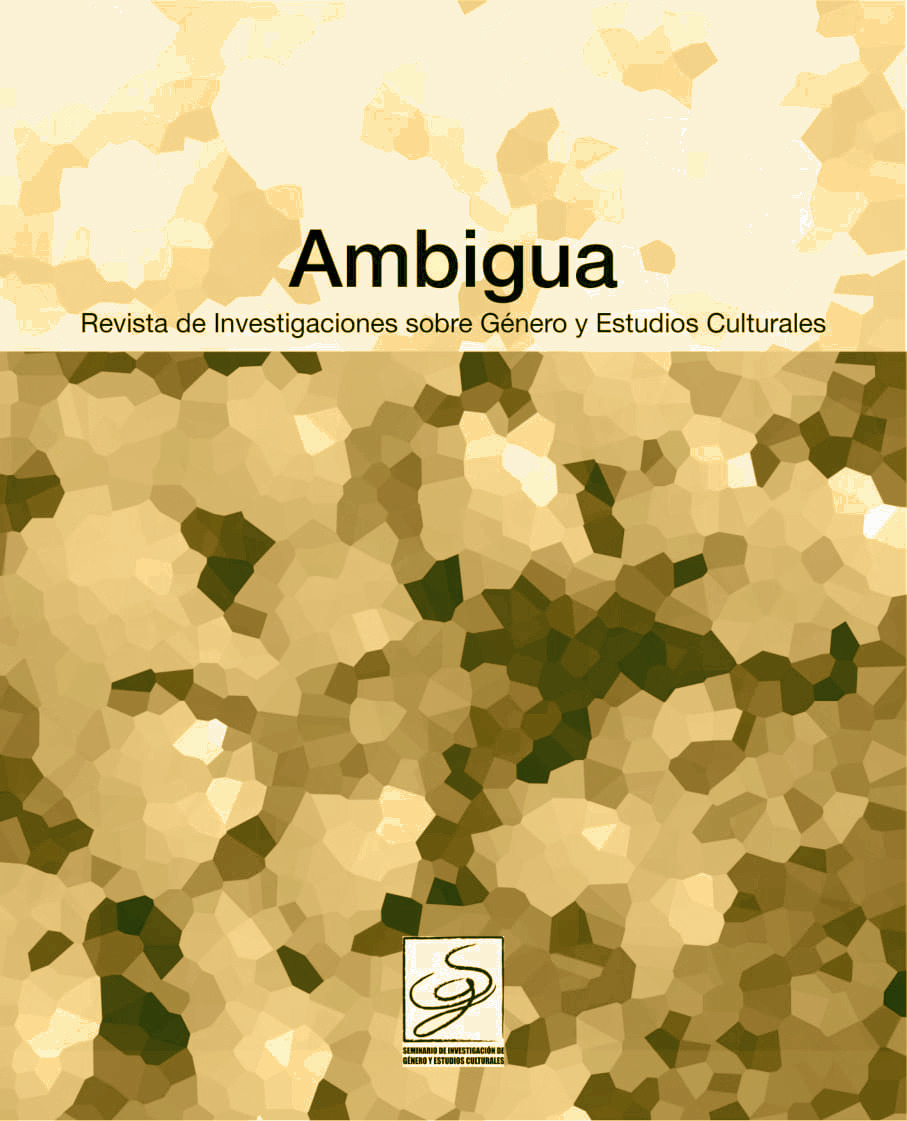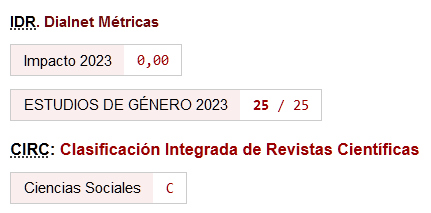La masculinidad en Gigante (George Stevens, 1956): el hombre a través de la música de Dimitri Tiomkin
DOI:
https://doi.org/10.46661/ambigua.6841Palabras clave:
Hombre, Masculinidad, Cine, Música de cine, Dimitri Tiomkin, GiganteResumen
Pese a su carga dramática, Gigante (George Stevens, 1956) ha sido incluida desde el principio dentro del género wéstern. Dentro de los elementos que lo caracterizan como tal se encuentra la figura del hombre en sus múltiples facetas: vaquero, terrateniente, renegado, soldado, médico. Cada una de ellas es definida narrativa y visualmente a través de recursos propios de la disciplina cinematográfica, con más o menos apego a las convenciones del género. Pero ninguna de esas descripciones está completa sin la música, la cual termina de modelar cada detalle de la personalidad de los personajes, mostrando la verdadera realidad de las diferentes masculinidades existentes en pantalla y, de alguna forma, más allá de ella. Mediante el uso de herramientas específicas de análisis de música cinematográfica, complementadas con material de archivo, se describen y confrontan las diferentes formas de masculinidad propias del wéstern, demostrando la capacidad de la música y del compositor Dimitri Tiomkin para construir estereotipos que, en muchas ocasiones, sobrepasan el mito.
Descargas
Citas
Referencias bibliográficas
ALTMAN, Rick. Film/Genre. London: The British Film Institute, 2018.
ÁLVAREZ DE BLANCO, Roberto. Brand Beauty unleashed: the value of aesthetics in marketing. London: Routledge, 2020. https://doi.org/10.4324/9780429025495 DOI: https://doi.org/10.4324/9780429025495
ARNOLD, David L. G. "My rifle, my poni and Feathers: music and the making of men in Howard Hawks' Rio Bravo". Quaterly Review of Film and Video, 23, No. 3 (2006): 267-279. https://doi.org/10.1080/105092090503367 DOI: https://doi.org/10.1080/105092090503367
BAKER, Brian. Masculinity in fiction and film: representing men in popular genres. 1945-2000. London: Continuum, 2006.
BLANCO, Lucio. "Música para el cine". Trama y Fondo. Revista de Cultura, 29 (2010): 45-59.
BLANCO HERRERO, David; Rodríguez Contreras, Laura y Gutiérrez San Miguel, Begoña. "New forms of masculinity in wéstern films: the end of the Malboro Man?". Communication & Society, 34, no. 2 (2021): 1-14. https://doi.org/10.15581/003.34.2.1-14 DOI: https://doi.org/10.15581/003.34.2.1-14
CLEMENS WARRIC, Kren. James Dean: dream as if you'll live forever. Berkeley: Enslow Publishers, 2006.
COHAN, Steven y HARK, Ina Rae (Ed.). Screening the male: exploring masculinities in Hollywood cinema. London: Routledge, 1996.
COHAN, Steven. Masked men: masculinity and the movies in the fifties. Bloomington: Indiana University Press, 1997. DOI: https://doi.org/10.2979/2300.0
ELKIN, Frederick. "The Psychological Appeal of the Hollywood Wéstern". The Journal of Educational Sociology, 24, no. 2 (October 1950): 72-86. https://doi.org/10.2307/2263795 DOI: https://doi.org/10.2307/2263795
FERBER, Edna. Gigante. Madrid: Torres de papel, 2015.
FÜLÖP, Rebeca Naomi. Heroes, dames, and distress: constructing gender types in classical Hollywood film music. Dissertation. Michigan: University of Michigan, 2012.
GATES, Philippa. Detecting men: masculinity and the Hollywood detective film. Albany: State University of New York Press, 2006. https://doi.org/10.1353/book5095 DOI: https://doi.org/10.1353/book5095
GUIOL, Fred y MOFFAT, Ivan. Final screenplay of George Stevens' production of Edna Ferber 's novel Giant. Los Angeles, April 4, 1955.
HETTHERLY, Jonathan. Movies and masculinity: how films shape our understanding of gender norms. Florida: Mango Media, 2021.
HORAK, Jan Christopher. "Creating a minority cinema: Spanish-language film exhibition in Downtown Los Angeles before World War II", en: De las Carreras, María Elena y Horak, Jan Christopher (Ed.), Hollywood goes Latin: Spanish-language cinema in Los Angeles. Bloomington: Indiana University Press, 2019 https://doi.org/10.2307/j.ctvh9w20g.4 DOI: https://doi.org/10.2307/j.ctvh9w20g.4
HORROCKS, Roger. Male myth and icons: Masculinity in popular culture. London: MacMillan, 1995. DOI: https://doi.org/10.1057/9780230389397
https://doi.org/10.1057/9780230389397 DOI: https://doi.org/10.1057/9780230389397
HOWELL, Amanda. Popular film music and masculinity in action: a different tune. New York: Routledge, 2015. https://doi.org/10.4324/9780203382509 DOI: https://doi.org/10.4324/9780203382509
JASKOLLA, Stephan. The construction of black masculinity in blaxploitation and hood movies. Berlin: Grin Verlag, 2014.
JUSTO ESTEBARANZ, Ángel y PÉREZ GARCÍA, Lucía. "Del Japón feudal al planeta Akir: Estudio comparativo de la música en "Los siete samuráis" y sus remakes americanos". En AA.VV: AVANÇA CINEMA 2015, 159-166. Avança, Portugal: Ediçoes Cine-Clube de Avança, 20151.
JUSTO ESTEBARANZ, Ángel y PÉREZ GARCÍA, Lucía. "Influencias de la música para western de Dimitri Tiomkin en el spaghetti western". Ucoarte. Revista de Teoría e Historia del Arte, 4 (20152): 93-112. https://doi.org/10.21071/ucoarte.v4i0.9481 DOI: https://doi.org/10.21071/ucoarte.v4i0.9481
KESSLER, Kelly. Destabilizing the Hollywood musical: music, masculinity and mayhem. Hampshire: Palgrave. MacMilland, 2010. https://doi.org/10.1057/9780230290556 DOI: https://doi.org/10.1057/9780230290556
KRUTNIK, Frank. In a lonely street: film noir, genre and masculinity. London: Routledge, 2001.
MERCER, John y SHINGLER, Martin. Melodrama: genre, style and sensibility. New York: Wallflower, 2004.
MOSS, Marilyn Ann. Giant: George Stevens, a life on films. Madison: The University of Wisconsin Press, 2004.
PEBERDY, Donna. Masculinity and film performance: male angst in contemporary American cinema. Hampshire: Palgrave MacMillan, 2011. https://doi.org/10.1057/9780230308701 DOI: https://doi.org/10.1057/9780230308701
PÉREZ GARCÍA, Lucía y JUSATO ESTEBARANZ, Ángel (2016). "Harry Sukman y Sam Fuller. Música para un wéstern de culto: Cuarenta pistolas (1957)". Pasaje a la Ciencia, 18 (2016): 9-19.
PÉREZ GARCÍA, Lucía. "El paisaje y la música en los wésterns de Dimitri Tiomkin". Imafronte, 25 (2018): 9-32.
PÉREZ GARCÍA, Lucía: Música de cine en femenino: las mujeres en la filmografía de Dimitri Tiomkin. Sevilla: Editorial Universidad de Sevilla: 2022.
ROMÁN, Alejandro. El lenguaje musivisual: semiótica y estética de la música cinematográfica. Madrid: Visión Libros, 2008.
SIMMON, Scott. The invention of the Wéstern film: a cultural history of the Genre's first half-century. New York: Cambridge University Press, 2003.
SMYTH, J. E. "Jim Crow, Jett Rink, and James Dean: Reconstructing Ferber's Giant (1952-1956)". American Studies, 48, No. 3 (Fall 2007): 5-27. https://doi.org/10.1353/ams.0.0118 DOI: https://doi.org/10.1353/ams.0.0118
SMYTH, J. E. Edna Ferber's Hollywood: American fiction of gender, race and history. Austin: University of Texas Press, 2010. https://doi.org/10.7560/719842 DOI: https://doi.org/10.7560/719842
SPRINGER, Claudia. James Dean transfigured: the many faces of rebel iconography. Austin: University of Texas Press, 2007. https://doi.org/10.7560/714434 DOI: https://doi.org/10.7560/714434
STAFFORD, Roy. Understanding Audiences and the Film Industry. London: British Film Institute, 2007. https://doi.org/10.5040/9781838711832 DOI: https://doi.org/10.5040/9781838711832
"The simple life of a busy bachelor. Rock Hudson gets rich alone". Life (October 3, 1955): 129-132.
TIOMKIN, Dimitri. "Composing for films". Films in Review, 2.9 (1951): 17-22.
WOOD, Robin. Rio Bravo. Vol. 72, Bfi Film Classics. London: British Film Institute, London, 2003.
WOODWORTH, Amy Jean. From buddy film to bromance: masculinity and male melodrama since 1969. Philadelphia: Temple University Libraries, 2014.
Fuentes documentales
AMPAS, Margaret Herrick Library. Department of Special Collections. George Stevens papers, GIANT - contracts, Box 49, f. 602. Dimitri Tiomkin’s contract for Giant. Jun 6, 1955.
AMPAS, Margaret Herrick Library, Department of Special Collections. George Steven papers, GIANT - music, Box 52, f. 651. Letter from Dimitri Tiomkin to George Stevens (s.f.).
AMPAS, Margaret Herrick Library, Department of Special Collections. George Steven papers, GIANT – contracts, Box 49, f. 602. Telegram from Ray Heindorf to J. L. Warner. Jan 4, 1956.
AMPAS. George Steven papers, GIANT - music, Box 52, f. 651. Music plot (From estimating script dated 10/22/54). Feb 8, 1955.
Páginas web y audovisuales
CROWTHER, Bosley, “Screen: Large Subject; The Cast”, The New York Times, October 10, 1956, https://www.nytimes.com/1956/10/11/archives/screen-large-subject-the-cast.html
George Stevens, dir. Gigante. Madrid: Warner Bros. Entertainment. 1999. DVD.
Variety Staff. “Giant”, Variety, October 10, 1956. https://variety.com/1956/film/reviews/giant-2-1200418151/
Descargas
Publicado
Cómo citar
Número
Sección
Licencia
Derechos de autor 2022 Lucía Pérez García

Esta obra está bajo una licencia internacional Creative Commons Atribución-NoComercial-CompartirIgual 4.0.
Las autorías que publican en esta revista están de acuerdo con los siguientes términos:
- Los autores conservan los derechos de autor y garantizan a la revista el derecho de ser la primera publicación del trabajo al igual que licenciado bajo Licencia Creative Commons Atribución-NoComercial-CompartirIgual 4.0 Internacional la publicación inicial en esta revista: Attribution-NonCommercial-ShareAlike 4.0 International (CC BY-NC-SA 4.0)
- Las autorías pueden establecer por separado acuerdos adicionales para la distribución no exclusiva de la versión de la obra publicada en la revista (por ejemplo, situarlo en un repositorio institucional o publicarlo en un libro), con un reconocimiento de su publicación inicial en esta revista.
- Se permite y se anima a las autorías a difundir sus trabajos electrónicamente (por ejemplo, en repositorios institucionales o en su propio sitio web) antes y durante el proceso de envío, ya que puede dar lugar a intercambios productivos, así como a una citación más temprana y mayor de los trabajos publicados (Véase The Effect of Open Access) (en inglés).
- Esta revista no cobra por publicar, es decir, no tiene APC's (the journal does not have article processing charges)
- Esta revista tampoco cobra ninguna tasa por el envío/presentación de trabajos (the journal does not have article submission charges)









